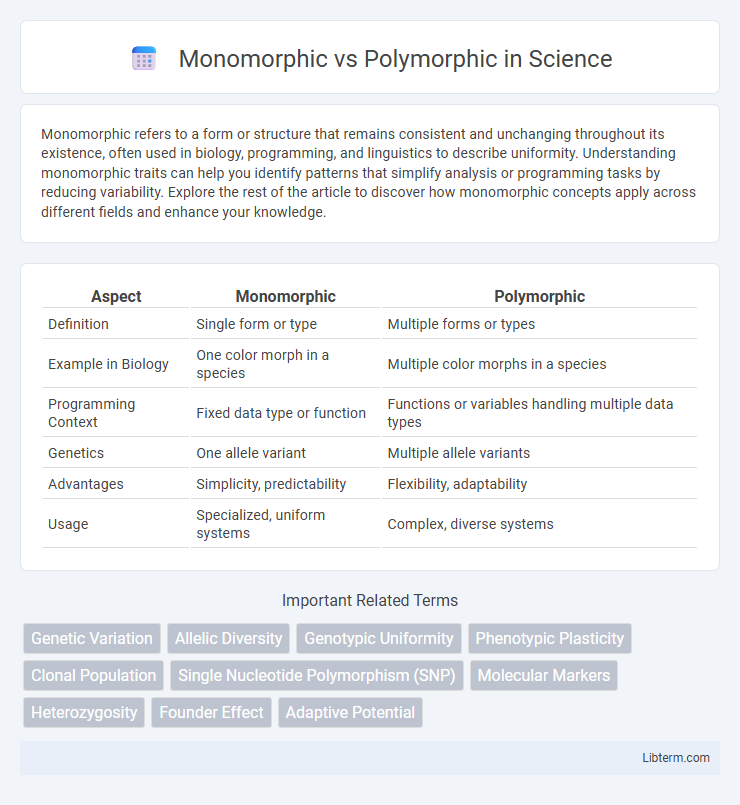Monomorphic refers to a form or structure that remains consistent and unchanging throughout its existence, often used in biology, programming, and linguistics to describe uniformity. Understanding monomorphic traits can help you identify patterns that simplify analysis or programming tasks by reducing variability. Explore the rest of the article to discover how monomorphic concepts apply across different fields and enhance your knowledge.
Table of Comparison
| Aspect | Monomorphic | Polymorphic |
|---|---|---|
| Definition | Single form or type | Multiple forms or types |
| Example in Biology | One color morph in a species | Multiple color morphs in a species |
| Programming Context | Fixed data type or function | Functions or variables handling multiple data types |
| Genetics | One allele variant | Multiple allele variants |
| Advantages | Simplicity, predictability | Flexibility, adaptability |
| Usage | Specialized, uniform systems | Complex, diverse systems |
Introduction to Monomorphic and Polymorphic Concepts
Monomorphic concepts refer to structures or functions that operate with a single, fixed type, ensuring predictability and simplicity in behavior. Polymorphic concepts enable entities to handle multiple types through abstraction, promoting flexibility and code reusability by adapting to various data types dynamically. Understanding these foundational definitions clarifies how programming languages implement type systems to balance strictness and versatility.
Defining Monomorphism: Key Characteristics
Monomorphism refers to a function or type that operates uniformly across a single, specific data type, ensuring consistent behavior and type safety. Key characteristics include a fixed type parameter, absence of type variations, and direct mapping to concrete types without branching logic. This contrasts with polymorphism, where functions or types can handle multiple data types through generalized or flexible definitions.
Understanding Polymorphism: Core Principles
Polymorphism in programming allows objects to be treated as instances of their parent class rather than their actual class, enabling methods to operate differently based on the object's specific type. This core principle supports code flexibility and reusability by allowing one interface to represent different underlying data types or classes. Understanding polymorphism is essential for implementing dynamic method dispatch, method overloading, and overriding, which enhance object-oriented programming effectiveness.
Historical Context and Evolution of Monomorphism & Polymorphism
Monomorphism and polymorphism originated from early programming language design, where monomorphic types were fixed and limited in flexibility, while polymorphism allowed functions and data structures to operate on multiple types. The evolution of these concepts is closely tied to the development of type systems in functional programming languages such as ML and Haskell, which introduced parametric polymorphism to enhance code reusability and abstraction. Over time, polymorphism expanded to include subtyping and ad-hoc polymorphism, enabling more dynamic and expressive programming paradigms beyond the initially rigid monomorphic constructs.
Main Differences Between Monomorphic and Polymorphic
Monomorphic refers to having a single form or type, commonly seen in programming with data types or functions that operate on one specific type, whereas polymorphic allows multiple forms or types, enabling functions or entities to process different data types through techniques like generics or inheritance. The main difference lies in monomorphic systems being statically typed and rigid, while polymorphic systems offer flexibility and reusability by supporting type generalization and dynamic binding. Polymorphism enables code abstraction and extensibility, whereas monomorphism prioritizes simplicity and type safety.
Monomorphic vs Polymorphic: Advantages and Disadvantages
Monomorphic types offer simplicity and improved performance due to uniform data structures but lack flexibility for varying data forms. Polymorphic types provide versatility by supporting multiple data types and enhancing code reuse, though they can introduce complexity and runtime overhead. Choosing between monomorphic and polymorphic depends on balancing efficient execution against the need for adaptable, reusable code in software design.
Real-world Applications in Biology and Computer Science
Monomorphic traits, exhibiting a single form, are prevalent in certain animal populations, influencing genetic stability and species identification, while polymorphic traits, displaying multiple forms, enhance adaptability and evolutionary potential in ecosystems. In computer science, monomorphic types simplify program design by enforcing uniform data structures, whereas polymorphic systems enable flexible code reuse and dynamic function behavior, crucial for developing robust software architectures. Both biological polymorphism and computer science polymorphism leverage diversity to optimize functionality and resilience in their respective domains.
Case Studies: Monomorphic Examples vs Polymorphic Examples
Monomorphic case studies often highlight software with a single, clearly defined data type, such as a banking application that handles fixed financial transactions ensuring type safety and predictable performance. Polymorphic examples typically include applications like graphic design software, where functions operate on multiple data types such as vectors, bitmaps, and text, enhancing flexibility and code reuse. Real-world analyses reveal that monomorphic designs excel in straightforward, performance-critical scenarios, while polymorphic approaches provide adaptability in complex, evolving systems.
Factors Influencing Monomorphic or Polymorphic Traits
Genetic variation, environmental conditions, and selection pressure critically influence whether traits manifest as monomorphic or polymorphic within a population. High genetic diversity and fluctuating environments often promote polymorphic traits by favoring multiple alleles, whereas stable environments and strong directional selection typically lead to monomorphic traits, where a single allele dominates. Mutation rates and gene flow also impact trait distribution, shaping the balance between phenotype uniformity and variability.
Future Trends and Research Directions
Future trends in monomorphic and polymorphic systems emphasize adaptive algorithms that enhance performance and flexibility in software design. Research directions explore hybrid models combining monomorphic efficiency with polymorphic versatility to address evolving computational needs. Advances in machine learning and type theory continue to drive innovations, optimizing code maintainability and execution speed in diverse application domains.
Monomorphic Infographic

 libterm.com
libterm.com